The Land of 10,000 lakes has some good birding for locals and visitors alike. There are 66 parks that you can visit and trails abound, provided that you know where to look. Today we’ll explore the popular backyard birds of Minnesota and discuss a little about exactly that. We’ll tell you where to look, what to look for, and what kind of treats and eats can tempt the local winged celebrities into gracing your feeder with their presence. Let’s talk about the popular backyard birds of Minnesota!
3 Categories – 246 Birds
Minnesota has over 246 species of birds that visit seasonally and while this isn’t as high a count as some states that doesn’t mean that you can’t do some serious birding here. There are some amazing birds that you can see in Minnesota and we have taken a sampling of some of our favorites and divided them up seasonally as follows:
- Year-round Resident birds
- Birds of Spring, Summer, and Early Fall
- Fall and Winter Birds
We will let you know more about each bird, by means of description data, food preferences, and where they like to spend their time so that you can maximize your chances of a successful sighting and set that feeder up with precision to attract the types of birds that you are hoping to see. While we can’t promise results, the data is good and will certainly increase the likelihood of visits. Without further ado, let’s get started!
Minnesota’s Year-Round Resident Birds
In this category we have taken a sampling of only the most dedicated denizens. These birds love Minnesota and call it their home, to the effect that you can see them at any time of the year. Here are some full-time residents for you to keep watch for:
- Downy Woodpecker
- Black-capped Chickadee
- White-breasted Nuthatch
- Pileated Woodpecker
- Raven
Downy Woodpecker – Picoides pubescens
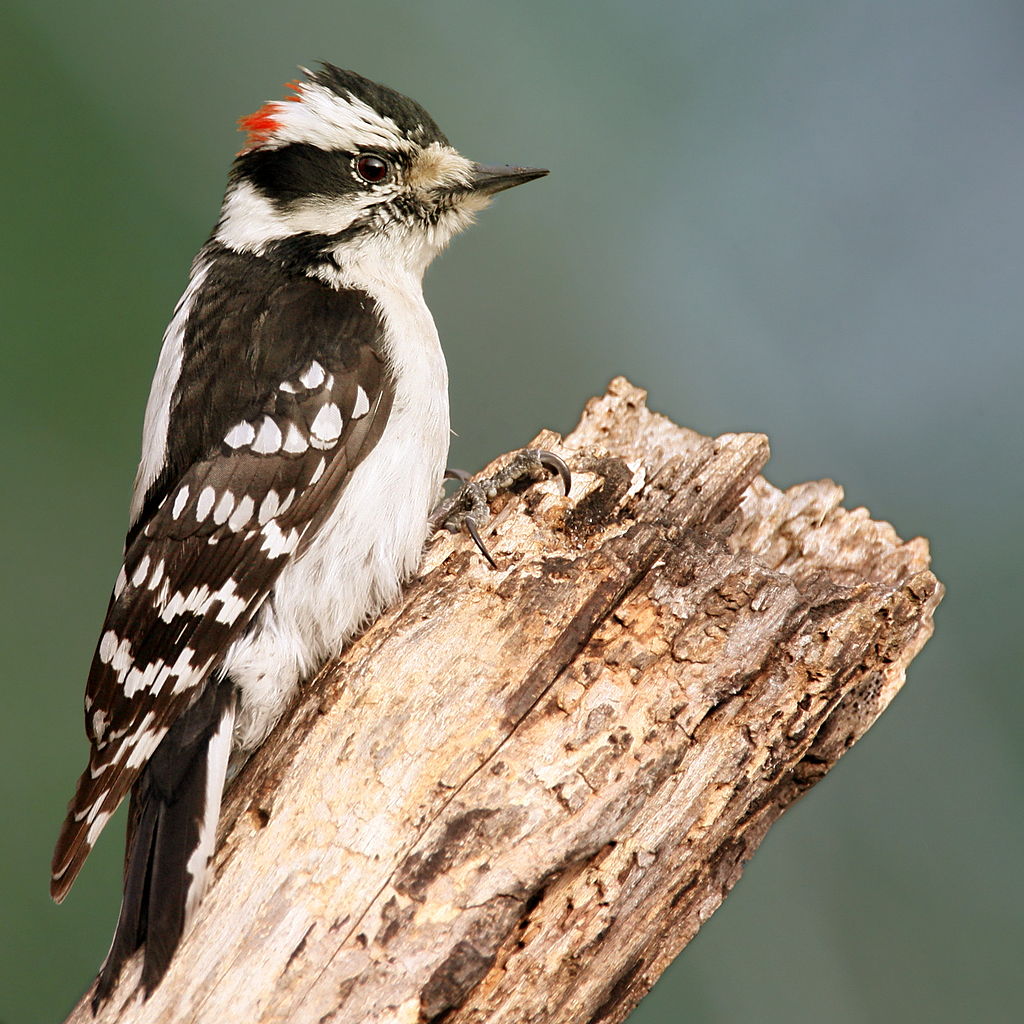
Coloration and Markings: Downy Woodpeckers have white backs with black wings, which have zigzag lines of white spotting that created a sort of checkerboard pattern across in the wings. They have small, rounded black tails with white undersides and their breast and underbelly is also a bright white. Facially, these birds have white faces with a mustache line as well as a mask which goes across the eyes to the back of the head. This bird has a thin, black cap and on the males it terminates at a red spot but remains simply black with the females. These birds have small, straight black bills.
Size: Quite small compared to most Woodpeckers, these birds measure in at 5.5 – 6.7 inches in length with wingspans of 9.8 to 11.8 inches.
Habitat: These birds love open, wooded areas, such as the forest’s edge or parks. They also love fruit and will visit orchards, gardens, and well-stocked backyard feeders.
Diet: These little guys like a lot of different foods. Some of their favorites are peanuts, chunky peanut butter, suet, White Proso millet, and Black Oil Sunflower seeds. They have quite the sweet tooth, so fruit is well received and you might even catch them drinking the sugar water from your Hummingbird feeders!
Black-capped Chickadee – Poecile atricapillus
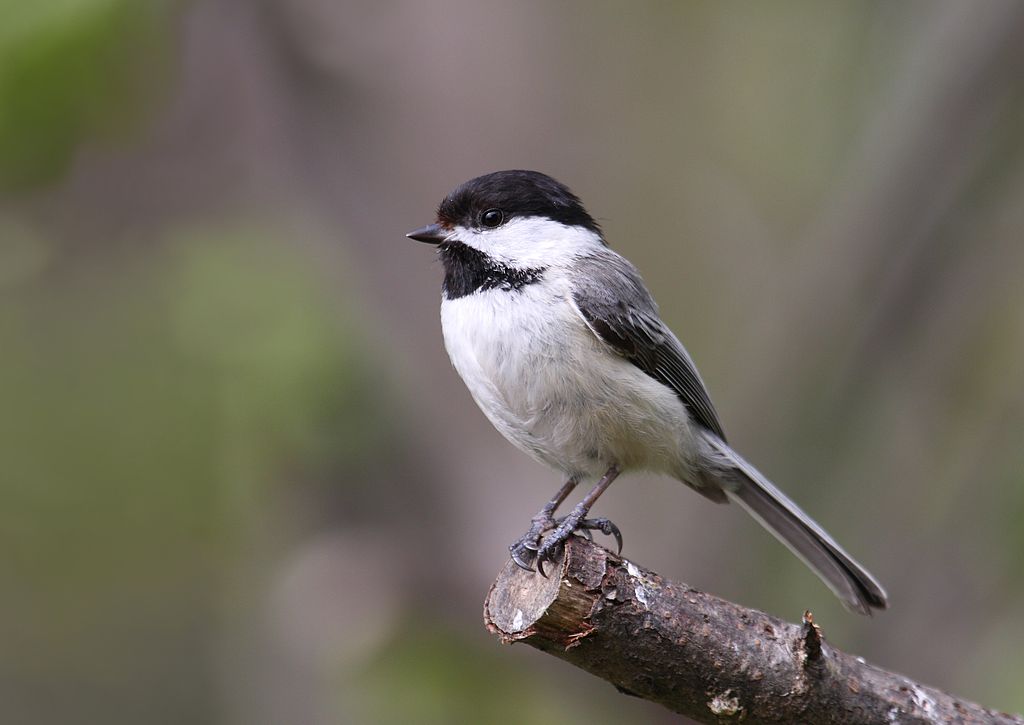
Coloration and Markings: Black-capped Chickadees have gray backs, wings, and medium-sized tails with some white edging highlighting the gray. They have a snow white breast and underbelly and facially, a white face with a black bib and a large, black cap which goes from the top of the head to just under the eye. These birds have tiny eyes and small, black conical bills.
Size: This bird measures in at 4.7 – 5.9 inches in length with a wingspan of 6.3 to 8.3 inches.
Habitat: These birds are particular fond of Alder and Birch trees but you can find them just about anywhere in the forest. Your chances are greatly increased if there is some ‘cover’ nearby in the form of thickets, brambles, or shrubberies, where these birds like to go to feel secure while they are foraging.
Diet: Black-capped Chickadees are easy to please, just load up your feeder with peanuts, suet, and Black Oil Sunflower seeds and once they notice then you’ve made a new friend.
White-breasted Nuthatch – Sitta carolinensis

Coloration and Markings: White-breasted Nuthatches have soft gray backs, wings, and short tails with some black highlighting and white edging. They have a white breast and underbelly, with an orange-brown mark at the rump and facially these birds have white faces and a black cap. A distinctive thin, black line also travels out from the back of the eye and these birds have long, straight bills which are typically black on top and white on the bottom.
Size: These birds measure in at 5.1 – 5.5 inches in length with wingspans of approximately 7.9 to 10.6 inches.
Habitat: These birds love deciduous woods, being especially fond of Oak and Maple trees. You can find them either inside the woods proper or at the edges, but they will range into parks and backyards on occasion.
Diet: Black Oil Sunflower seeds, suet, peanuts, and chunky peanut butter are all items that will get this bird’s attention and keep them coming back for more!
Pileated Woodpecker – Dryocopus pileatus

Coloration and Markings: Pileated Woodpeckers have black back, wings, and long, black tails as well as a black breast and underbelly. Sometimes there will be flecks of white in the breast plumage and underneath the wings there are large, white patches which are visible when the bird is in flight. Facially, these birds have white faces with a red line running from the bill to the cheek as well as a mask which crosses the eyes and terminates at the back of the head. This is topped off with a small, striking red crest and this bird has a long, slightly curved black bill.
Size: These birds are large (about Crow sized), measuring in at 15.8 – 19.3 inches with wingspans of 26 to 29.5 inches in length.
Habitat: These birds prefer Evergreen and deciduous woods, where they tend to focus on dead trees, either standing or felled. They do range forth often into parks and backyards as well, so be sure to leave a little something out for them and you might just get a visit.
Diet: These birds love berries and nuts, so peanuts and some chopped cherries or strawberries make an excellent dessert. Make suet the main-course and you’ve got the makings for a merry Woodpecker feast!
Raven – Corvus corax
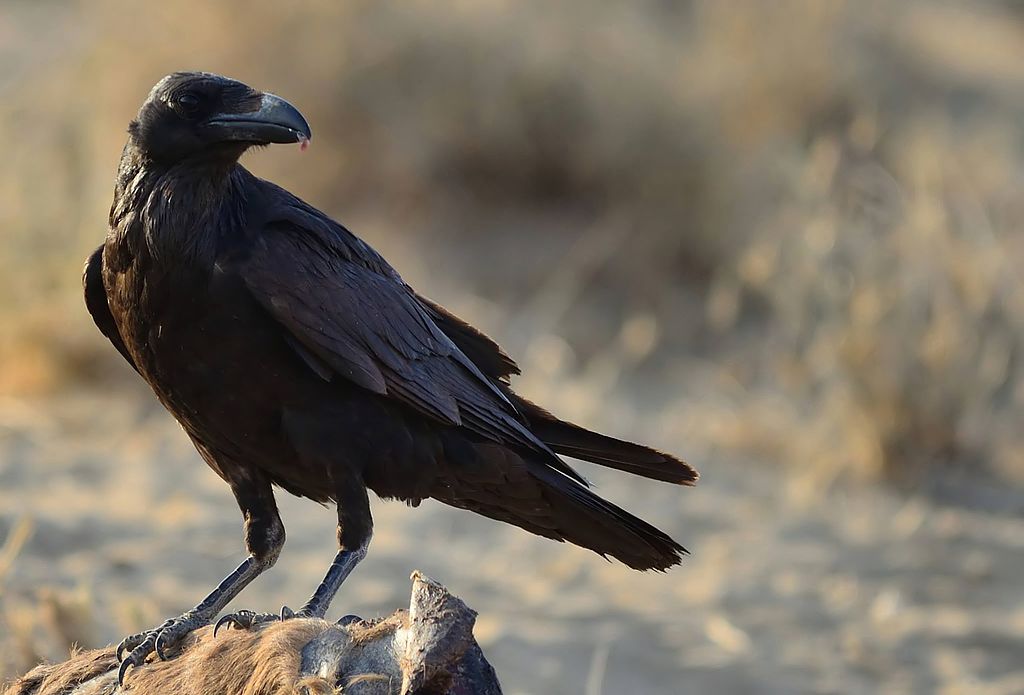
Coloration and Markings: Poe’s favorite bird, the Raven, is easy to identify. This bird is black from tip to tail with a long, stout and slightly curved bill.
Size: These birds measure in at 22.1 – 27.2 inches in length with wingspans of 45.7 to 46.5 inches.
Habitat: Yes, Minnesota really has Ravens! They tend to stay in the central areas of Minnesota so keep an eye out. Look for them just about anywhere, as they inhabit not only the deep forest but it’s edges and they are urbanized as well, spending time foraging in mall parking lots, dumpsters, backyards, or simply scouting out the local layout from telephone wires.
Diet: These birds are easy to please and eat just about everything (they’ll even steal your dogs food if they spot it!). To take some of the pressure off of Fido, leave out wome wheat, oats, and Black Oil Sunflower seeds if you would like to attract and feed a Raven. You can also attract them with a plastic or tin silhouette of a Raven-shape, painted black and placed on the fence. These birds see it and they think that other Ravens are visiting and they will come to investigate.
Minnesota’s Birds of Spring, Summer, and Early Fall
The prairies, woods, and wetlands of Minnesota begin breaking out the wildflowers in spring and it is definitely a magical time. Hepatica and Pasque flowers bloom first but after that the forest and its surroundings quickly transform into an almost magical array of colors. Here are some of the birds to look for once the Pasque flower begins to bloom and spring has officially started and for the months to follow as you progress to summer and early fall:
- Gray Catbird
- Barn Swallow
- Red-eyed Vireo
- Killdeer
- Red-winged Blackbird
Gray Catbird – Dumetella carolinensis

Coloration and Markings: Simple, yet elegant, Gray Catbirds are easy to identify and a joy to behold. Their bodies are almost completely a soft gray color with a few exceptions. First, there is some distinctive coloration on the underside of their long, tails. You will notice a brownish-red close to the rump while the rest of the underside is black. Facially, this bird often has some black from the bill to the front of the eye and a small, black cap at the top of its head. These birds have medium-sized, slightly curved black bills.
Size: These birds measure in at 8.3 – 9.4 inches with wingspans of 8.7 to 11.8 inches.
Habitat: These birds love dense vegetation, preferring brambles, thickets, and shrubs at the forest’s edge. If you have some bushes in your backyard then this increases your chances of a visit but if not, don’t worry, just stock up your feeder with the right goods and the Gray Catbird may still visit.
Diet: These birds have a sweet tooth. Try leaving out assorted, dried fruits of some fresh chopped apples or strawberries for best results.
Barn Swallow – Hirundo rustica
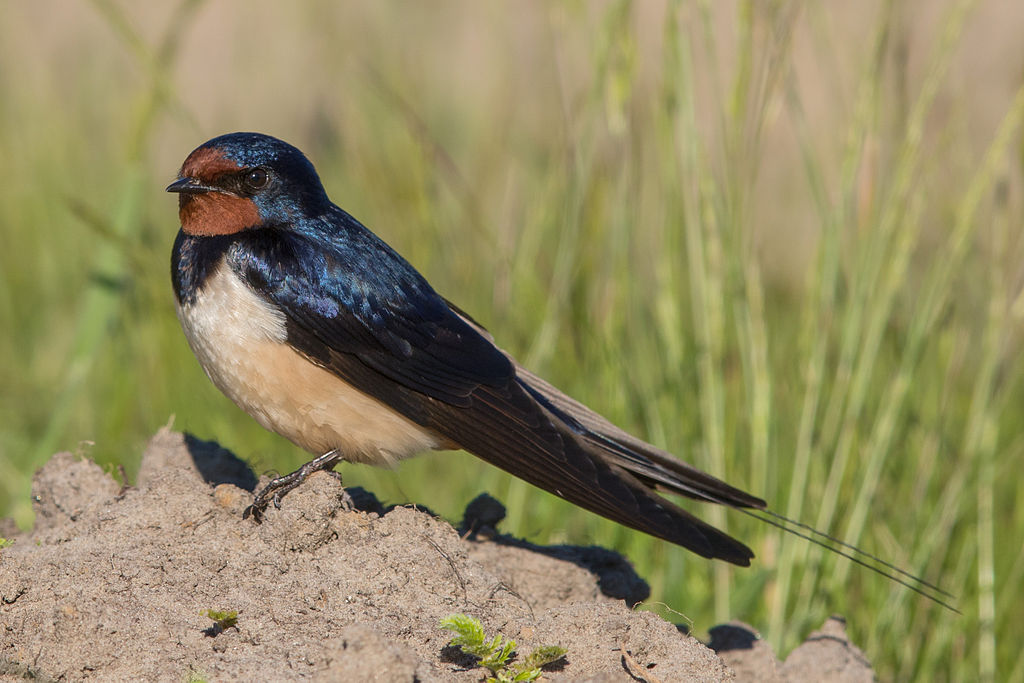
Coloration and Markings: Barn Swallows look like little superheros, with blue backs, wings, and long, forked tails which are blue with some white edging. Some white spots underneath these tails may be noticed when the bird is in flight. The blue coloration from the upper body extends over to the breast as a blue line on each side converging towards the neck, as if the bird is wearing a cape. The breast and underbelly are a lovely cinnamon red, with some white often seen just under the wings and coming back from the neck towards the back. Facially, this cinnamon coloration takes up the lower half of the face, outlining the underside of the cheek and triangulating to top just over the bill. The top half of the face is blue and this bird has a black, diamond-shaped mask over the eyes just in front of a short, straight bill. Females have the same coloration but the colors are not as bold.
Size: These birds measure in at 5.9 – 7.5 inches in length and have wingspans of 11.4 to 12.6 inches.
Habitat: These birds love open areas such as fields and parks and they are also quite fond of water, foraging often in marshes or next to ponds. They do like backyard feeders so be sure to let them know that you are thinking of them and you might just get some visitors.
Diet: These birds primarily eat insects but they also like berries, try some dried or fresh assorted berries and add some crushed eggshells. Barn Swallows often eat eggshells and it is believed that they assist in digestion.
Red-eyed Vireo – Vireo olivaceus
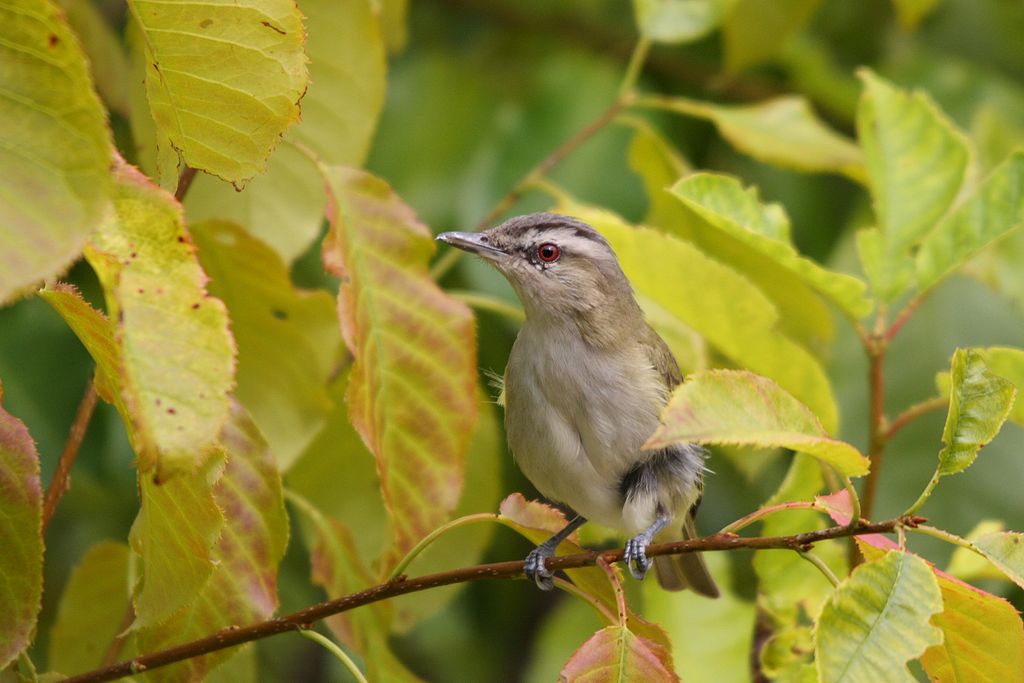
Coloration and Markings: Red-eyed Vireos have yellow-green backs, wings, and tail with some gray occasionally present on the wings and tail and the occasional black feather highlighting on both. The breast and underbelly of this bird are white and facially, This bird has a mostly olive-green face with white starting from underneath the bill down to the chin, as well as presenting as a line above and below the eyes, around a thin, olive-green to brown mask that travels over the eyes to the back of the head. This bird also has a black eyebrow mark, a gray crown, and a straight, medium-sized, and conical black and white bill. As the name suggests, the adult birds of this species do indeed have red eyes when viewed up close but juveniles will only have dark colored eyes.
Size: These tiny birds measure in at 4.7 – 5.1 inches in length with a wingspan of 9.1 to 9.8 inches.
Habitat: These birds love deciduous forests but will visit the occasional park or backyard, especially during the winter.
Diet: Red-eyed Vireos are primarily insectivorous but they do like to supplement their diet with fruits. Chopped up apples, strawberries, or cherries can get excellent results or you can try whatever dried fruits that you have on hand.
Killdeer – Charadrius vociferus

Coloration and Markings: The Killdeer is a little pirate with wings and now that we have pointed that out you won’t be able to help yourself from seeing it! They are easy to identify, with brown and tan back, wings, and short tails. In flight, you can sometimes see some orange on their rump as well, but you have to get a good look or you’ll miss it. This birds has a white breast and underbelly and as you follow the coloration upwards you will see a distinctive black band at the base of the throat followed by white which goes up to under the chin. This bird has more white in front of the bill, outlining and topping the eye, and a dark line at eye-level that goes through the eye and then down the neck, like a pirate’s eyepatch. The cheek and the crown of this bird’s head are black and it has a long, straight black bill.
Size: Roughly Robin-sized, these birds measure in at 7.9 – 11 inches in length with wingspans of 18.1 to 18.9 inches.
Habitat: These birds love open areas, either inland or coastal, so you can see them at sandbars or simply wandering around the lawn as they search for their lunch or dinner.
Diet: Killdeer eat mostly insects, though they will also eat crayfish or snails. Try leaving out some dried crickets or mealworms in a ground feeder and you might just tempt the Kildeer to spend a little time in your yard.
Red-winged Blackbird – Agelaius phoeniceus

Coloration and Markings: Red-winged Blackbirds are easy to recognize, being black all over with some distinctive differences you’ll quickly notice. The back and wings often have ‘stylized’, thin red markings and the shoulders bear large, telltale red and yellow shoulder marks. At rest, the yellow often looks like a straight line with a ‘shark’ fin coming out of it that you can’t miss. They also have medium-length, conical black bills. We should note that if you see these in California they won’t have the yellow, but in Minnesota both the yellow and red will be present.
Size: These birds measure in at 6.7 – 9.1 inches in length with wingspans of 12.2 to 15.8 inches.
Habitat: Red-winged Blackbirds love water, frequenting marshy areas, the edges of ponds, or even wet roads. They do still visit backyard feeders but your odds are best if the yard is a bit flooded after a heavy rain.
Diet: Grains and seeds are all you need. A simple combination is White Proso millet and Black Oil Sunflower seeds. Just mix them up, leave them out, and watch the fun!
Minnesota’s Fall and Winter Birds
With temperatures falling down to as low as 12 degrees Fahrenheit, Minnesota winters are… well, we were going to say that they were ‘nothing to sneeze at’ but then we thought that through. Ahem. Minnesota winters probably do, indeed, invoke a bit of sneezing, but not for these hardy birds. Undaunted by the chill, they frolic and forage with abandon, just daring you to spot them. See if you can lure or catch a glimpse of one of these birds when it’s cold out:
- Hairy Woodpecker
- Dark-eyed Junco
- Purple Finch
- Pine Siskin
- Red-bellied Woodpecker
Hairy Woodpecker – Dryobates villosus
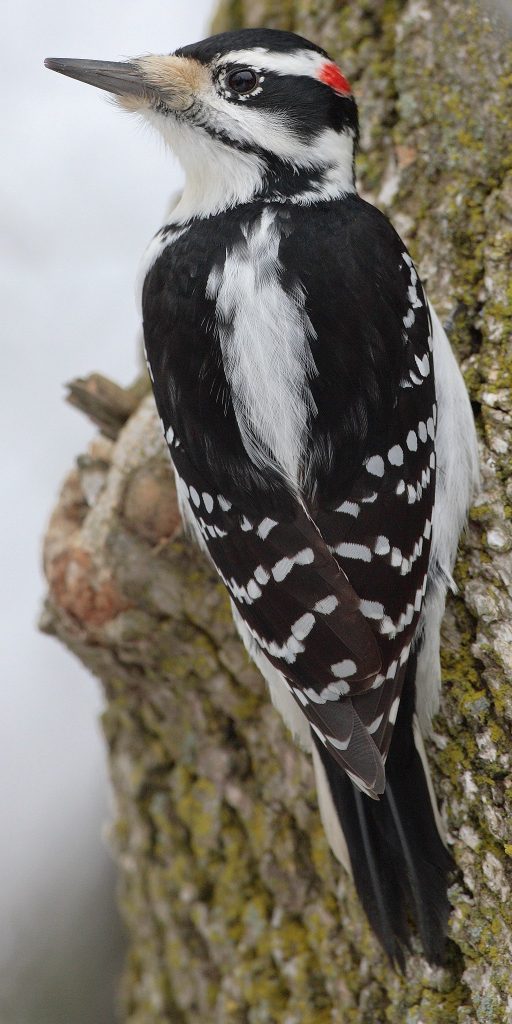
Coloration and Markings: This bird looks like a larger version of the Downy Woodpecker with a longer bill. It has black back, wings, and tail with distinctive white spots creating checkered lines on the wings and short, black tails with white undersides. They have a white breast and underbelly and facially, a mustache line travelling from the bill to connect with the back of the head as well as a black mask across the eyes. A thin black cap completes the look, with the males having a red mark at the back of the head in addition to this. This bird’s bill is long, black, and slightly curved upwards.
Size: This bird measures in at 7.1 – 10.2 inches in length with an wingspan averaging 12 – 16.1 inches.
Habitat: These birds love older forests, where they especially favor Pine and Oak trees. Felled trees also get their attention for the promise of delicious insects. These birds do venture out into parks and will visit your backyard feeder as long as you’ve stocked it appropriately in anticipation of their visit.
Diet: Black Oil Sunflower seeds and suet are a powerful, easy combo that will keep the Hairy Woodpecker coming back for more.
Dark-eyed Junco – Junco hyemalis

Coloration and Markings: The Dark-eyed Junco displays a range of coloration based on region but the arrangement of coloration is quite distinct. Look for a bird with dark gray or brown back, wings, and long gray tails with white outer feather. The breast shows as being white in the center and heavily flanked by gray or brown while the underbelly and rump are white. When viewed at rest it appears as if the white is evenly divided as the bottom 1/3 of the bird. Facially, these birds have somewhat of an ‘angular’ look to the top of their heads, like they’ve gotten a military haircut, and they have medium sized, stout pink bills.
Size: These birds measure in at 5.5 – 6.3 inches in length with wingspans of 7.1 to 9.8 inches.
Habitat: When it is warm these birds prefer spending time in the forest, especially coniferous ones. They do range when foraging into fields, parks, and backyards from time to time, especially in the winter months.
Diet: Cracked corn, Black Oil Sunflower seeds, and White Proso millet are all that you need to host and possibly keep the Dark-eyed Junco at your feeder.
Purple Finch – Haemorhous purpureus
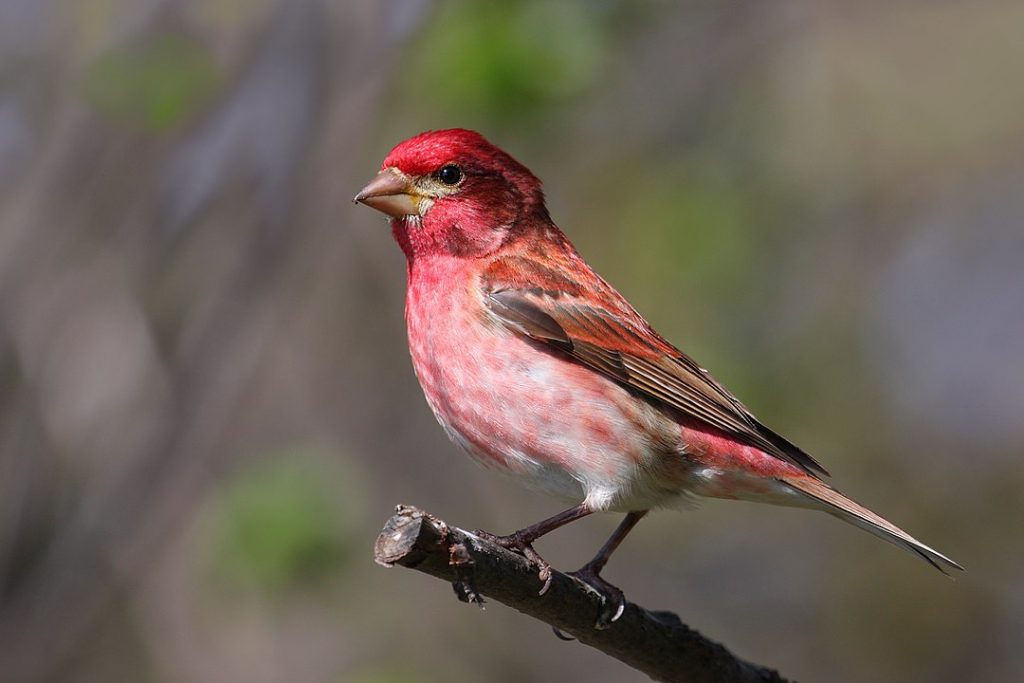
Coloration and Markings: Purple Finches are lovely, with light rose coloration mixed with browns on their back and wings. Dark coloration on the wings alternates with the red color, giving the appearance of vertical highlighting, and there is some white edging present as well. These birds have short, gray or brown tails with white edging and undersides, and the breast and underbelly are scored with rosy-red streaking which becomes fainter as you approach the underbelly. Facially, this bird is reddish pink with the deepest coloration on the top of the head, on an eyestripe that goes through the eye and curves down towards the back of the neck. A deeper colored marking also frames the check and thinly outlines the large, conical bill. This bill often has a black ‘splotch’ on the top half, but not always.
Size: These birds measure 4.7 – 6.3 inches long with wingspans of 8.7 to 10.2 inches.
Habitat: These birds spend most of their time in the forest, preferring deciduous, coniferous, or a mix of the two. In the winter they range out for a bit of foraging and favor shrubs and brambles for cover. They will happily visit your backyard, provided that you know what they like!
Diet: One easy food that you can use for this bird is Safflower seeds. Purple Finches love them and if you have squirrels you won’t have to worry, as they don’t like Safflower. You can also use Black Oil Sunflower seeds or Nyjer thistle, but Safflower is the easiest and best.
Pine Siskin – Spinus pinus

Coloration and Markings: Pine Siskins have brown backs, wings, and medium-length forked tails. The wings and tails display heavy streaking and light yellow coloration, both centered on the wing and tail and occasionally as edging. They have whitish breast and underbelly with heavy streaking present and facially, below the eye and under the bill there is undisturbed off-white coloration surrounded by the streaked remainder of the face. They have short, conical black and brown bills.
Size: These little birds measure in at 4.3 – 5.5 inches in length with wingspans of 7.1 to 8.7 inches.
Habitat: Pine Siskins love to haunt the open areas of deciduous and Evergreen forests, though when foraging they will also target gardens, open fields, and well-stocked backyard feeders.
Diet: Nyjer Thistle, Black Oil Sunflower seeds, and White Proso millet are all favorites of this bird. Add one or more to your feeder and watch these little birds go!
Red-bellied Woodpecker – Melanerpes carolinus

Coloration and Markings: Red-bellied Woodpeckers have an exotic, pleasing plumage. Their back and wings are white with black zebra-striping present which continues down to their short, striped tails. These tails are black and white on the underside and the breast and underbelly of this bird are white, with traces of red that look almost as if someone spilled juice on the bird. A darker red spot is often present on the belly and facially, they have white faces with faint red at the cheeks and a striking red cap from the bill to the back of the neck. These birds have long, straight black bills.
Size: These birds measure in at approximately 9.4 inches in length with wingspans of 12 to 16.5 inches.
Habitat: These birds prefer older forests, especially with Oak, Hickory, or Pines present. They definitely range, however, spending time in parks and backyards where they peck and forage for something tasty. You can make sure that they find it!
Diet: These birds like lots of different foods. Some favorites include peanuts, chunky peanut butter, suet, and Black Oil Sunflower seeds. They also raid Hummingbird feeders for the sweet taste of sugar water, so try breaking out the hummingbird feeder after stocking the regular foods if you really want to spoil your Woodpecker.
Supporting cast (Other Backyard Birds of Minnesota That Might Pay You a Visit)
In order to give you a few more feathered friends to find we thought we’d add a few more year-round birds that might just wander into your backyard at any time of the year. While they didn’t get booked for that fancy beginning spot in the article, these birds are celebrities in their own right. See if you can spot one of these ‘Supporting Cast’ birds the next time you are out on the town:
- American Robin
- Northern Cardinal
- American Goldfinch
- American Crow
- Song Sparrow
American Robin – Turdus migratorius
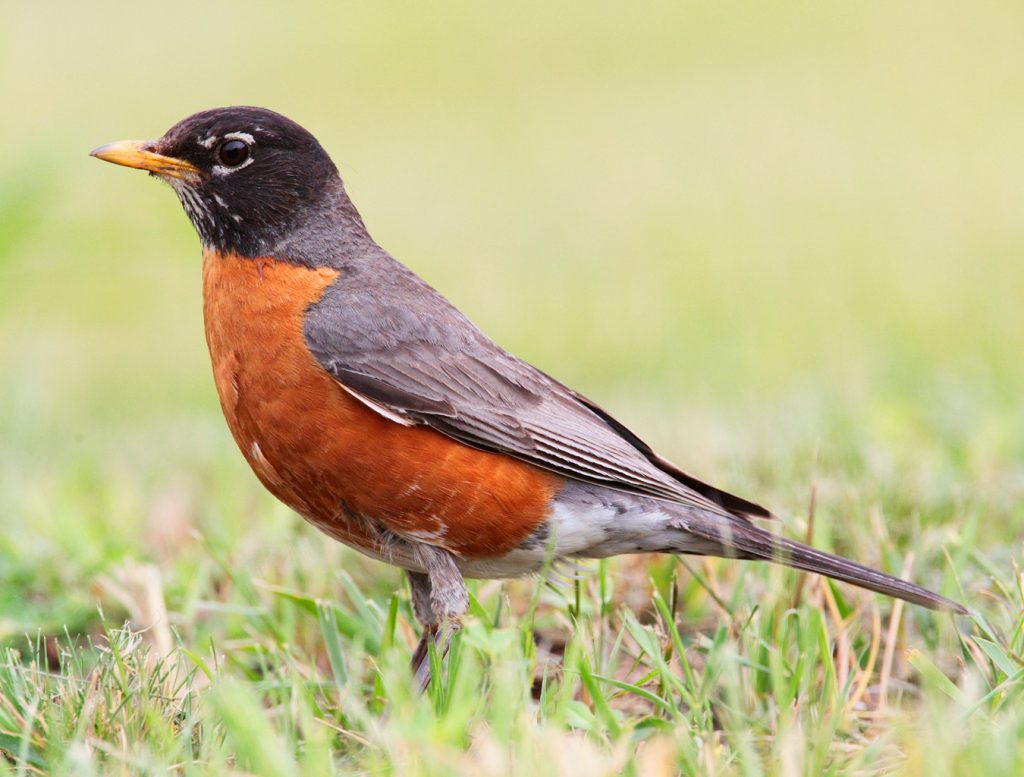
Coloration and Markings: American Robins have grayish-brown backs, wings, and long, gray tails with white undersides. Some minor white edging highlights the wings and these birds have a soft orange breast. This color extends down to the underbelly but becomes white at the rump. Facially, these birds have dark gray to black faces with some thin white outlining under the bill and distinct, fragmented white eyerings. These birds have short, slightly curved yellow bills.
Size: These birds measure in at 7.9 – 11 inches from tip to tail with wingspans of 12.2 to 15.8 inches.
Habitat: These birds can be found just about anywhere. You might see one hopping in the snow or foraging at your golf course. They might be in the woods, your local park, or on your fence scoping out that feeder of yours. Be sure there is something waiting and you’re sure to get a better look at the lovely American Robin.
Diet: Fruits and insects are the American Robin’s favorite fare, so add some mealworms and dried crickets to your feeder with some chopped apples or cherries on the side. Both you and your Robin guest will be happy that you did!
Northern Cardinal – Cardinalis cardinalis
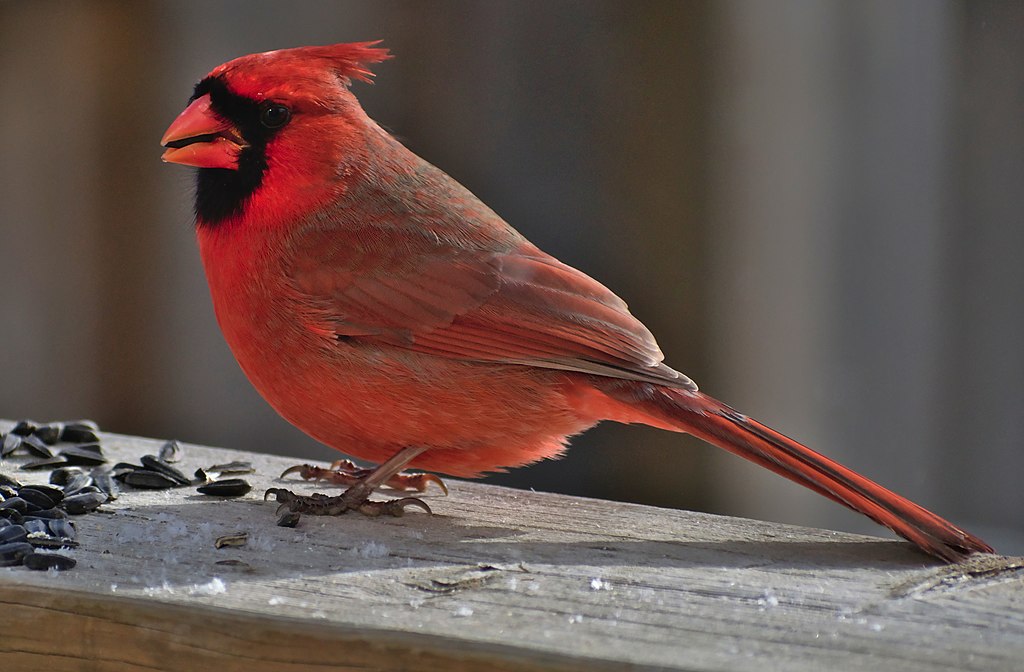
Coloration and Markings: Male Northern Cardinals are quite stunning, with a deep, vibrant red all over their bodies with the occasional exception of some gray feathers. Facially, they have large, beautiful crests and black masks which extend below the cheek like a sharp goatee. They have short, stout conical orange bills and the females, though colored differently are uite striking as well. They show brown plumage with hints of red adding to the décor though you will note a smaller or partial mask and bib.
Size: These birds measure in at 8.3 – 9.1 inches in length with a wingspan of 9.8 to 12.2 inches.
Habitat: These birds love brush, brambles, and thickets, and are not shy about towns or cities. They are more than happy to visit a full feeder in your backyard.
Diet: Lots of foods will meet with success when it comes to the Northern Cardinal. Cracked corn, peanuts and chunky peanut butter, and Black Oil Sunflower seeds are just a few of their favorites. Try these out the next time a Cardinal is close, if it gets the bird’s attention then you’ll soon have a visitor!
American Goldfinch – Spinus tristis

Coloration and Markings: The American Goldfinch is easy to recognize. They have bright yellow backs with black wings, with a single white wingbar present as well as vertical and assorted white marking as the coloration progresses to its long tail. They have bright yellow breast and underbellies, which turns to white at the rump and facially, they are bright yellow with a small cap starting at the center of the head and continuing to the stout, conical orange bill.
Size: These diminutive lovelies measure in at 4.3 – 5.1 inches with wingspans of 7.5 to 8.7 inches.
Habitat: The birds like bramble, thorns, and thickets as well as floodplains or plain old overgrown fields. A bit of cover attracts them but they also regularly visit orchards, gardens, and backyards so be sure to leave out something yummy.
Diet: You can attract and often keep the attentions of the American Goldfinch with a simply mix of Black Oil Sunflower seeds and Nyjer thistle. Try it out and see what happens!
American Crow – Corvus brachyrhynchos

Coloration and Markings: American crows are completely black, with some brown present when they are molting, and they have large, stout bills with a definite curve to them.
Size: These birds measure in at 15.8 – 20.9 inches in length with a wingspan of 33.5 to 39.4 inches.
Habitat: American Crows prefer open spaces, be it in woods, fields, or parks. They know that the places where people live are often full of tasty snacks, as well, and so they aren’t shy of human habitation. These birds will definitely visit your backyard.
Diet: These birds eat just about anything but 2 easy favorites are peanuts and crunchy peanut butter. Put them out and you’ll soon you might have some very happy crows.
Song Sparrow – Melospiza melodia
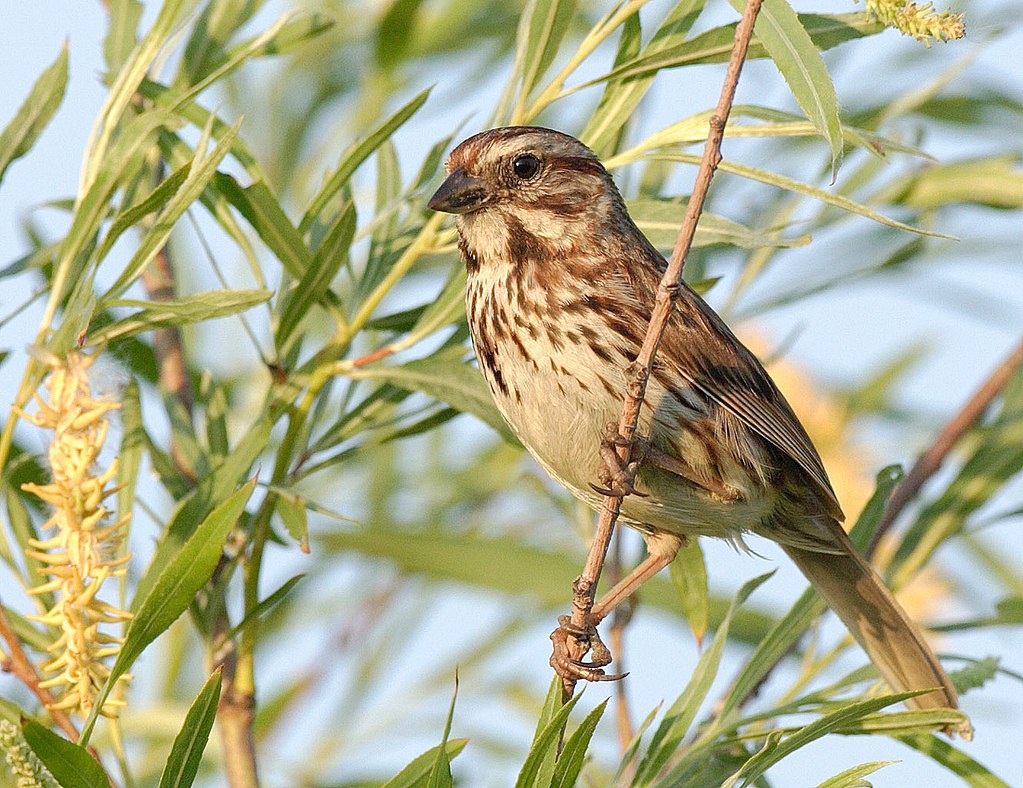
Coloration and Markings: Song Sparrows have nice coloration, with streaked brown back, wings amd medium-sized fanning tails. The breast and underbelly are whitish=gray with brown streaking and facially look for a white mustache-mark on a face that is a mix of gray and brown (with the gray commonly taking up a large part of the face around the eyes). These birds have short, stout gray bills.
Size: These birds measure in at 4.7 – 6.7 inches in length with a wingspan of 7.1 to 9.4 inches.
Habitat: When Song Sparrows are not spending time at the forest’s edge they prefer open areas or areas with water. You can see them at the edges of marshes and ponds, in fields, parks, and especially in backyards well-stocked in anticipation of their visit.
Diet: These birds love grain, berries, and seeds. White Proso millet it one of their favorites but you might also try some chopped cherries or strawberries and Black Oil Sunflower seeds.
Minnesota Bird Buffet
When it comes to selecting the right seeds for attracting the most birds the Minnesota Department of Natural Resources has some great recommendations that they have divided by seasons. Today we’ll share with you some of their spring recommendations as well as a few of ours and the link to their article so that you can see some more of the seasonal recommendations. Here are some of the ones for spring:
- Suet
- Grape Jelly
- Overripe bananas
- Cornbread
- Mealworms
For more information on the seasonal feeder recommendations from the Minnesota Department of Natural Resources you can visit this link: https://www.dnr.state.mn.us/birdfeeding/index.html
Minnesota Birding Hot Spots
If you wish to try your hand at the Chirparazzi art of finding and even taking photos of the beautiful birds of Minnesota then this is your lucky day! We’ve got a list of hotspots located at the compass points of the state, including a central location so that you can find a place that is close to you. We’ll be sure to share a link where you can learn more or find other, possibly convenient spots but we hope that this will help you to get started. Be sure to visit one or more of these spots to see some Avian Angels in their element:
- Northern hotspot – Arrowhead State Trail
- Eastern hotspot – Swedish Immigrant Trail
- Southern hotspot – Blazing Star State Trail
- Western hotspot – Central Lakes State Trail
- Central hotspot – Sunrise Prairie Trail
Detailed descriptions of each location as well as information regarding visiting and what birds you can see at these locations may be found at https://www.traillink.com/stateactivity/mn-birding-trails/
In Conclusion
Today we have explored the popular backyard birds of Minnesota and we hope that you’ve had as much fun reading about them as we have had in researching them. Minnesota has some beautiful birds and locations where you can find them, so if you aren’t having a lot of luck luring them in you should definitely consider treating yourself to a trip to one of the many, many trails where you can find them. Until next time, load up that feeder and lock the cat inside, and have yourself a good time birding!
